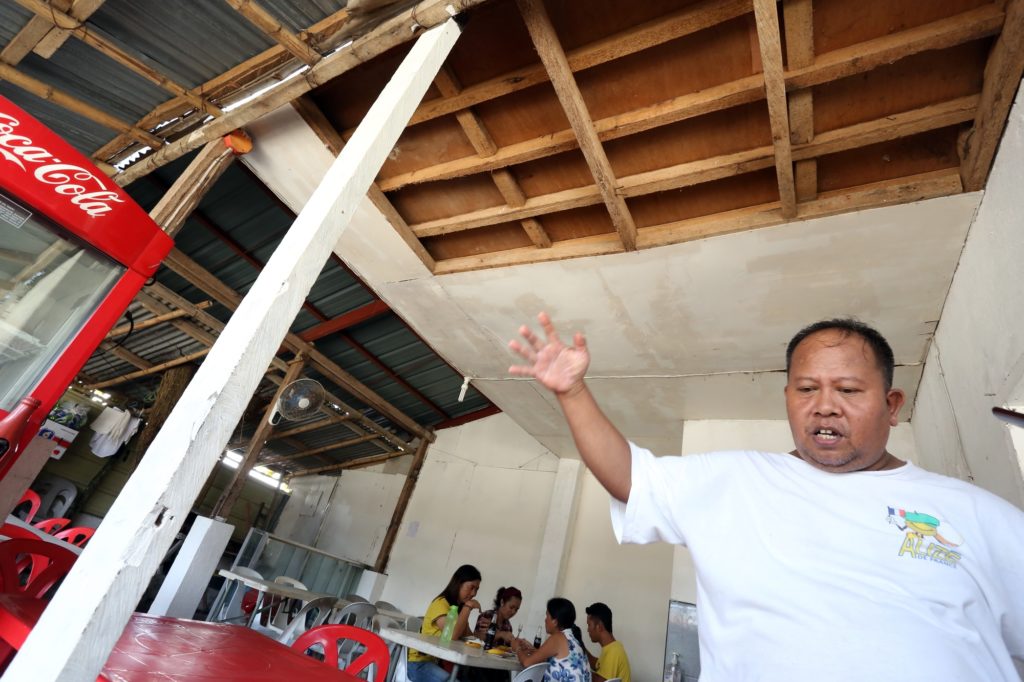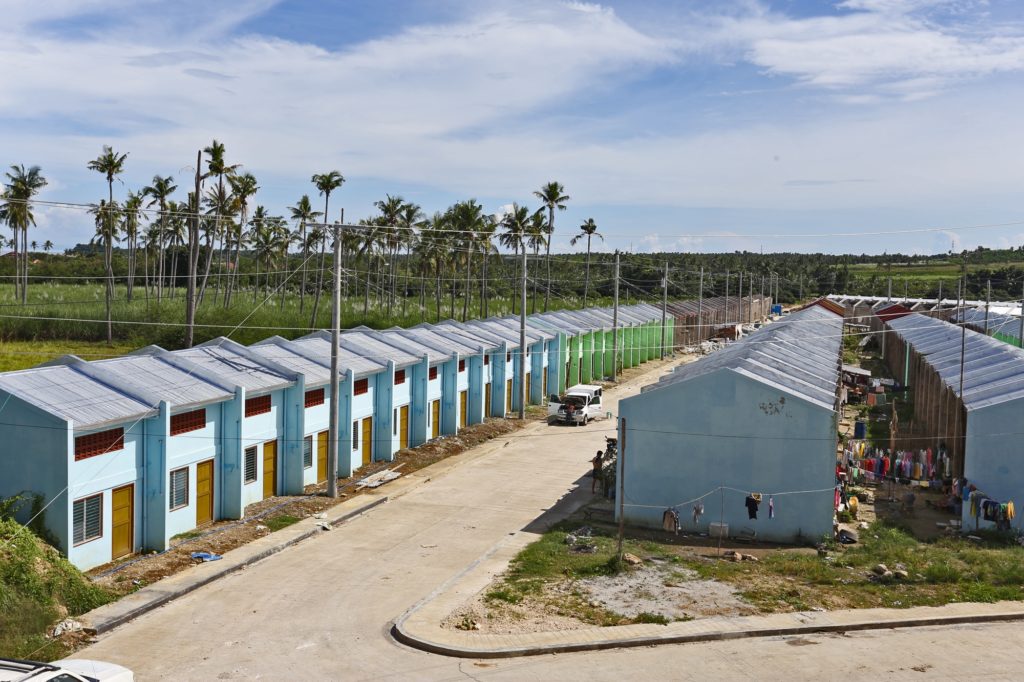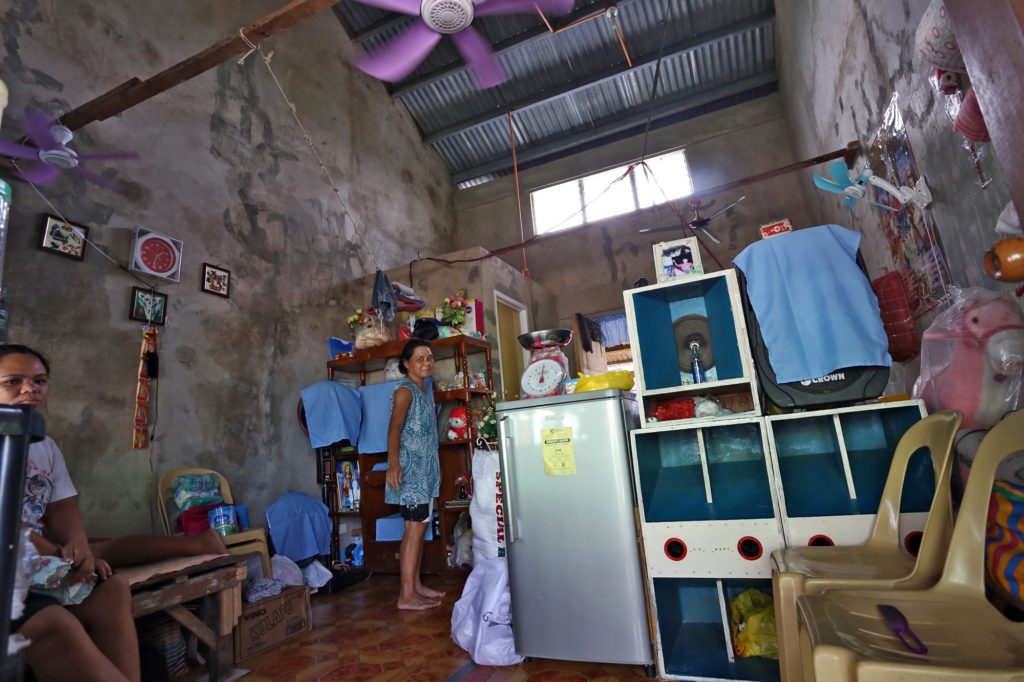4 years after Super Typhoon Yolanda: Survivors’ tales of woe in need of a happy ending

SURVIVOR’S TALE. Jose Lomocso narrates how Super Typhoon Yolanda destroyed his eatery and the other houses in Daanbantayan, Cebu, in this interview on November 2, 2017, days before the fourth anniversary of the deadly storm.
CDN PHOTO/JUNJIE MENDOZA
Even after four years, Jose Lomocso still remembers the wrath of Super Typhoon Yolanda (international name Haiyan) like it happened only yesterday.
“Mura gyud lagi og gibombahan ang lungsod (The whole town looked like it was bombed),” the 46-year-old cook from Daanbantayan in northern Cebu said as he recounted his experience to Cebu Daily News.
At 4 a.m. on November 8, 2013, Kusina sa Daanbantayan, a small eatery located at the corner of Osmeña and Rizal Streets in Barangay Poblacion, had just finished preparing the meals they would serve to hungry customers later in the day.
The residents of the town have been warned there would be a strong storm coming that morning. But this was hard to believe as the sea was calm and the sky was clear just a few hours before the typhoon made landfall, Lomocso said.
He said residents did what they could to storm-proof their homes, but it did not seem enough to dampen the force of the typhoon.
By 7 a.m., the galvanized iron sheets used as roofing material for most of the houses in the town began to rattle violently as Super Typhoon Yolanda passed through Cebu, bringing with it strong winds rushing at a speed of more than 300 kilometers per hour (kph).
Lomocso and two others at the eatery tried to hold on to the establishment’s wooden door to keep it from flying away, but the winds were too strong even for three people.
“Nakasangpit gyud ko sa Ginoo. Ingon ko luwasa kami (I called on God to save us),” he said.
Other establishments in the vicinity were not doing any better as these were brought down by the storm in just a matter of minutes.
The storm had stopped around mid-day. But it left in its wake torn-down houses, streets littered with broken wood and other debris, and a memory its survivors would forever look back on.
“It was a good thing we already had food prepared before the storm and they weren’t spilled,” Lomocso said in Cebuano.
Daanbantayan, located 123 kilometers from Cebu City at the northernmost tip of mainland Cebu, turned out to be among areas worst hit by Yolanda, which barreled across central Philippines, packing maximum winds of up to 315 (kph), bringing Tacloban City and the rest of Leyte, Samar, northern Cebu, Panay and Negros Islands a level of destruction that was unparalleled in the country’s recent history.
In the case of Lomocso’s store, food that was supposed to be sold to customers that day was instead given for free to residents who lost their homes to the typhoon.
Slow recovery
Lomocso recalled that they were able to rebuild their eatery three months after the typhoon hit the town, and he is now doing business as usual.
Today, Lomocso chooses to look forward to brighter things.
For 50-year-old Alicia Mantos, however, the recovery was not as swift.
It was only last June 30 this year when her family was allowed to move in to one of the houses at Maya Park Homes, a relocation project by the National Housing Authority (NHA) in Barangay Maya, still in Daanbantayan.
She lives with her 48-year-old fisherman husband Crisologo, two children and one grandchild.
The Mantos family was among 14 families who were evicted from their homes in the coastal community of Pasil after the owner of the land they have lived in for over four decades decided to use the property for other purposes.
“We asked the mayor (Vicente Loot) to help us and give us somewhere to live, and he said we can stay here,” she told CDN.
In 2013, their old house made of wood and concrete was wiped out by the storm.
Unfortunately, they were not eligible for relocation because they lived outside the danger zone and were only given housing materials composed of wood and iron sheets after the disaster.

UNFINISHED BUSINESS. The housing project of the National Housing Authority (NHA) for the victims of Super Typhoon Yolanda in Barangay Maya, Daanbantayan, Cebu. (CDN Photo/Junjie Mendoza)
The family was dependent on relief goods from the Department of Social Welfare and Development (DSWD) for about a year, but Mantos said even the assistance would sometimes arrive late.
Mantos said she was elated that they finally moved in to a better home.
Maya Park Homes, located in Sitio Ayong, is a P187-million project covering 5.5 hectares with 650 units, each measuring 25 square meters, being built by Hi-Tri Development Corporation.
Today, Mantos runs a home-based sari-sari store to augment her husband’s income.
The houses are made of concrete while residents have access to water and electricity, but the site is far from the main road, prompting its tenants to take habal-habal (motorcycle-for-hire) rides to the town proper where they have work. Each ride costs P15 to P20.
“This is already better than nothing. We’re not fully on our feet yet, but we are getting there,” Mantos said in Cebuano.
More needs to be done
Four years after Yolanda, the scars left by the disaster are now barely visible.
Along the highway traversing Cebu’s northern towns, lush vegetation now occupy what used to be land filled with uprooted trees immediately following the typhoon.
Houses showed no signs of earlier damage, its inhabitants giving no hint of what they went through years before.
But this is only a snapshot, a tree within the forest.
Four years after Yolanda, there is still work to be done, especially in the area of resettlement housing projects being implemented by the National Housing Authority (NHA).
In Central Visayas, where those hit by the typhoon were mostly towns in northern Cebu, only 1,648 permanent housing units have been completed while 262 units are still being constructed as of October 30, 2017, based on data obtained by CDN from the Office of the Presidential Assistant for the Visayas (Opav).
According to the latest status report, a total of 22,423 housing units are needed in the area, 19,604 of which have already been bid out.
Out of the completed housing units, 1,127 are in mainland Cebu, including 496 in Daanbantayan and 631 in Medellin, while 521 are on Bantayan Island, 71 of which are in Sta. Fe while 450 are in Bantayan.
Among those that are still being constructed, 190 are in Daanbantayan while 72 are in the town of Sta. Fe on Bantayan Island.
There are still projects that have not been started yet due to several reasons, including those in Daanbantayan (1,463), Tabuelan (220), Medellin (569), San Remigio (1,224), Bogo City (1,500), Tabogon (184), Borbon (400), Sogod (491), Tuburan (170), Sta. Fe (1,305), Bantayan (1,590), Madridejos (3,693), as well as San Francisco (1,960), Poro (275), Tudela (258) and Pilar (660) on Camotes Island.
NHA earlier projected the need for 220,000 housing units for those in northern Cebu who lost their homes to Yolanda.
Reasons for delay
While the government hasn’t completed a single resettlement project since that fateful day, many private organizations, both local and foreign, have helped build for affected families during the first three years after the storm.
Resettlement projects make up only 1.1 percent of the total number of projects, but have been allocated the biggest amount out of the total budget at 52.10 percent or P6.57 billion.
Titus Borromeo, Opav spokesperson, said that while reasons for the delay vary, among those that are most common are the lack of land titles, absence of bidders, no general management plan (GMP) from the Department of Environment and Natural Resources (DENR), no right of way, no water and electricity connection, and the need for land conversion.
The proposed two-year moratorium on the processing and approval of all applications for all land-use conversion of agricultural lands for nonagricultural uses was also seen to have implications to the government’s resettlement efforts.
However, the Department of Agrarian Reform (DAR) this year has allowed land conversion for victims of the typhoon.
Even with the GMPs for Bantayan and Camotes Islands, towns on the latter island still need to wait for a fund transfer before contractors can begin work on resettlement housing projects there.
The contractors of projects on mainland Cebu, meanwhile, are still complying with Notice of Assessment (NOA) requirements while others are waiting for feedback on their Request for Assistance (RFA).
Meanwhile, the Regional Development Council in Central Visayas (RDC-7) in September 2016 passed a resolution requesting the NHA Board to relax the land title requirements for resettlement sites in northern Cebu.
The Opav co-chairs the Inter-Agency Task Force (IATF)-Yolanda, created through Administrative Order No. 5 issued by President Rodrigo Duterte last August 8, which aims to unify the implementation and monitoring of rehabilitation and recovery projects and programs in Yolanda-affected areas.
Borromeo said that the Opav continues to lobby for the fast-tracking of the implementation of Yolanda recovery projects not only in Central Visayas but in all of the areas hit by Yolanda in the Visayas.
Last Nov. 10, 2016, President Duterte appointed Wendel Avisado as Presidential Assistant for Yolanda Rehabilitation.
Avisado also sits as co-chair of the IATF-Yolanda, which Cabinet Secretary Leoncio “Jun” Evasco Jr. leads.

Alice Mantos shows the interior of the housing project of the National Housing Authority (NHA) for the victims of Super Typhoon Yolanda in Barangay Maya, Daanbantayan town, that she now occupies.
CDN PHOTO/JUNJIE MENDOZA
Completed projects
Presidential Assistant for the Visayas Michael Dino, in November last year, ordered contractors working on housing projects in the towns of Daanbantayan, Medellin and Bantayan to turn over housing units by the end of 2016.
The previous administration has allotted P12.61 billion for 2,796 projects undertaken by various line agencies for the rehabilitation of typhoon-ravaged areas in the region, which are mostly towns in northern Cebu.
Around 75 percent of these projects, classified into four clusters, have been completed as of September 2016.
Two thousand seven hundred ninety six (2,796) projects worth P12.61 billion undertaken by various line agencies for the rehabilitation of typhoon-ravaged areas in the region, which are mostly towns in northern Cebu, have been completed as of September 2016.
Among agencies under the infrastructure cluster that have completed their projects are the Department of Public Works and Highways (DPWH) for the repair of national roads, bridges, civic centers, barangay halls and drainage systems worth P422.86 million; Department of Energy (DOE) for the rehabilitation of lines and substations which cost P112.35 million; and the Department of Transportation (DOTr) and Cebu Port Authority (CPA) for the repair of ports worth P38.27 million.
Under the livelihood cluster, the Department of Trade and Industry (DTI) through the Small Business Corp. (SB Corp) provided P500 million in loans to affected businesses, while the Technical Education and Skills Development Authority (Tesda) completed skills training projects worth P37.02 million.
Other agencies that have completed more than half of their projects include the Department of Education (DepEd) for the repair of classrooms at P382.45 million, Department of Interior and Local Government (DILG) for the repair of public buildings worth P79.03 million, and the Department of Social Welfare and Development (DSWD) for the P2.23-billion Emergency Shelter Assistance (ESA).
Disclaimer: The comments uploaded on this site do not necessarily represent or reflect the views of management and owner of Cebudailynews. We reserve the right to exclude comments that we deem to be inconsistent with our editorial standards.
